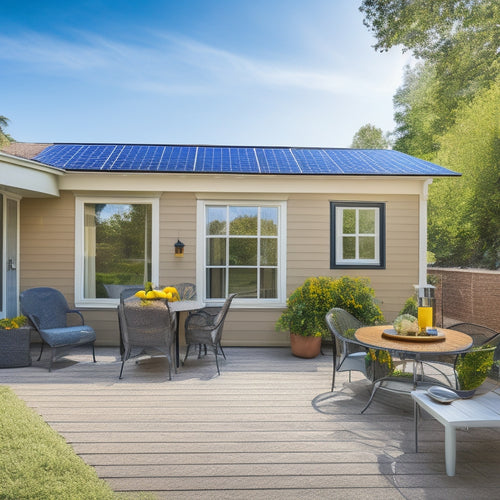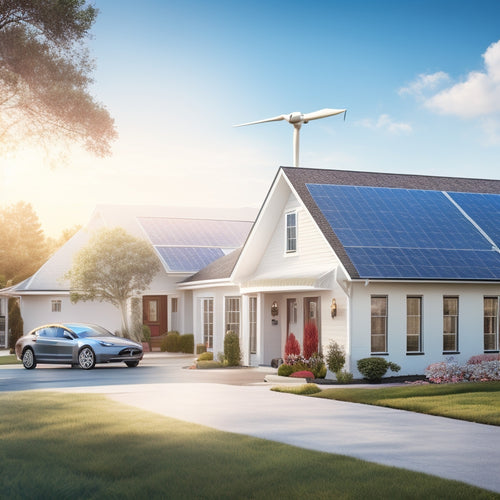
Solar Battery Installation and Their 3 Cost Breakdowns
Share
You're investing in a solar battery installation, and understanding the three key cost breakdowns is essential for a feasibility assessment, with the upfront investment being a significant factor that can range from $5,000 to $15,000 or more, depending on the battery type and installation requirements. Hardware and installation expenses are the next major consideration, involving costs for inverters, mounting hardware, and wiring, as well as installation permits. Finally, ongoing maintenance fees, averaging $100 to $300 annually, will guarantee your system operates efficiently and extends its lifespan. Now that you've got a sense of the costs involved, you can start making informed decisions about your solar battery installation.
Key Takeaways
- Understanding upfront investment costs is crucial for assessing the feasibility of solar battery installation.
- The type of battery (lithium-ion or lead-acid) significantly impacts upfront costs and overall lifespan.
- Installation expenses include hardware costs, permits, and labor, and can vary depending on the installer and location.
- Ongoing maintenance fees, ranging from $100 to $300 annually, are necessary for peak performance and longevity.
- Accurate investment assessment should include total cost of ownership, including upfront, installation, and maintenance costs.
Understanding Solar Battery Costs
When contemplating solar battery installation, your upfront investment is a critical factor, and understanding solar battery costs is essential to determining the feasibility of this renewable energy solution for your home or business.
You'll need to contemplate the type of battery you require, as different battery types have varying price points. Lithium-ion batteries, for instance, are more expensive than lead-acid batteries, but offer longer lifetimes and deeper depth of discharge.
You'll also need to factor in financing options, which can greatly impact your overall cost. You may opt for an outright purchase, or investigate financing options such as loans or power purchase agreements.
These financing options can help spread the cost over time, making solar battery installation more accessible. Additionally, you may be eligible for incentives like tax credits or rebates, which can further reduce your expenses.
Hardware and Installation Expenses
You've got a handle on the costs associated with different battery types and financing options, now it's time to drill down into the nitty-gritty of hardware and installation expenses. This is where the bulk of your solar battery installation costs come into play.
The type of battery you choose will greatly impact your upfront costs, with lithium-ion batteries typically being the most expensive option. However, they also offer the most energy density and longest lifespan, making them a popular choice for many homeowners.
In addition to the battery itself, you'll need to factor in the cost of installation materials, such as inverters, mounting hardware, and wiring. These components can add up quickly, so be sure to get quotes from multiple installers to compare prices.
Don't forget to also budget for installation permits, which can range from $500 to $2,000 depending on your local government's requirements. By understanding these costs, you can make an informed decision about which battery type and installation company is right for you.
Ongoing Maintenance Fees
With your solar battery installation up and running, it's vital to factor in the ongoing maintenance fees to guarantee peak performance and longevity.
You'll need to budget for regular checks and maintenance to make certain your system operates at its best. The maintenance frequency will depend on the type of battery and system you have. For example, lithium-ion batteries typically require less maintenance than lead-acid batteries.
On average, you can expect to pay between $100 to $300 per year for maintenance, depending on the complexity of the system and the frequency of visits. Proper maintenance is critical to extend the battery lifespan, which typically ranges from 10 to 15 years.
Failure to maintain your system can lead to reduced performance, efficiency, and lifespan. When calculating the total cost of ownership, it's vital to include these ongoing maintenance fees to get an accurate representation of your investment.
Frequently Asked Questions
Can I Install Solar Batteries Myself to Save on Labor Costs?
You can attempt a DIY installation, but it's essential you're aware of the safety considerations involved, like electrical shock and fire hazards, to guarantee a safe and successful project that meets your power needs.
Do Solar Batteries Work During a Power Grid Outage?
When the grid goes dark, your solar battery becomes a guiding light, providing reliable power during outages. You'll be prepared, thanks to your solar battery's ability to disconnect from the grid and operate independently, ensuring your essential appliances stay running.
Are Solar Batteries Compatible With Existing Solar Panel Systems?
You'll find that most solar battery types are designed for seamless solar panel integration, allowing you to upgrade your existing system with ease, as long as your panels are relatively modern and meet the battery's compatibility requirements.
Can I Add More Batteries to My System in the Future?
You're likely aware that 70% of solar owners consider energy storage essential; now, you're wondering if you can add more batteries in the future. Yes, you can, and it's ideal for future expansion, as most battery types, like lithium-ion, are designed for scalability and easy integration.
Do Solar Batteries Have a Warranty or Guarantee?
You'll find that most solar batteries come with a warranty or guarantee, typically ranging from 5 to 15 years, which covers defects and performance degradation, but you'll still need to factor in maintenance requirements to guarantee ideal lifetime expectancy.
Related Posts
-

Why Higher Upfront Costs Are Worth It
You pay a premium for high-quality, energy-efficient products, but they're worth it. With durability testing ensuring...
-

10 Tips to Buy Affordable Solar Panels Online
When purchasing affordable solar panels online, you'll want to research reputable retailers, compare prices, and chec...
-

Why Homeowners Are Embracing DIY Energy Independence
By taking control of your energy needs, you're breaking free from the uncertainty of utility bills and embracing a se...


